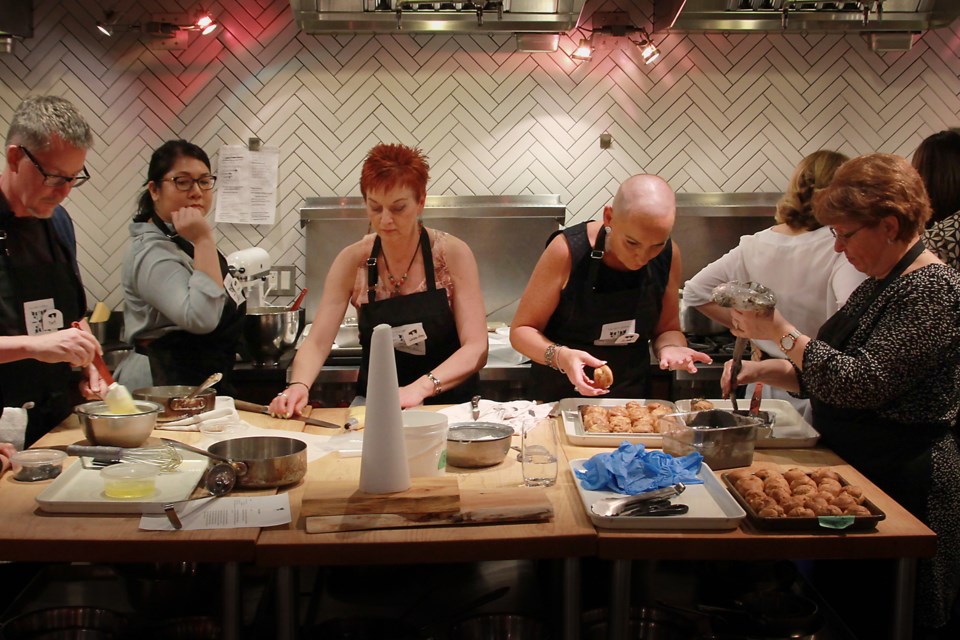On a balmy Saturday night, 30 students — almost all women — gathered at the Dirty Apron (540 Beatty St.) with a glass of bubbly in one hand, school-issued black apron in the other, united in one singular pursuit. Croquembouche.
Croquembouche is fancy French terminology for “towering pyramid of creampuffs held together by skin-searing caramel.” As part of the EAT! Â鶹´«Ă˝Ół»festivities, instructors Anna Olson (TV host and author of several cookbooks) and Jackie Kai Ellis (owner of Beaucoup Bakery) blitzed through a 10-minute demo for pâte Ă choux and three flavours of pastry cream. And then they split everyone into teams.
Team white chocolate-rhubarb divided and conquered: a mother-daughter pair made a pot of caramel, four healthcare professionals from Surrey made creampuffs, two twentysomething friends filled pre-made puffs with pre-made custard and my partner, Iris, and I made pastry cream.
Next, Olson and Kai Ellis showed everyone how to attach the puffs to an inverted cone using molten caramel glue, then instructed us to do the same. They made it look easy, but it’s remarkable how spun sugar and edible flowers can mask all manner of sins. Though slightly lopsided, our croquembouche stood as a monument to what can be achieved in three short hours.
The croquembouche was a team effort, similar in style to the Dirty Apron’s corporate teambuilding classes, which include the Â鶹´«Ă˝Ół»Canucks as clients. But the majority of the school’s classes are hands-on, where students cook every element of a multi-course meal.
And so, a week later, I joined 19 other students for a brunch class with owner David Robertson. He demonstrated how to turn a knobby potato into matchsticks, poach eggs and make sundried tomato hollandaise, passing along tips he’d collected over a career in kitchens. At the end of our hard work, everyone decamped to the dining room to enjoy their first course.
“How is everything tasting?” asked our server.
I wondered if I could send it back if I didn’t like it. But the truth is, it was one of the better brunches I’ve had in a long time. I looked to my friend Jen, who handily overcame her performance anxiety to make golden and crispy potato rosti, perfectly poached eggs and buttery hollandaise speckled with sundried tomatoes.
“This is really good,” she said between mouthfuls of rosti and sips of Moroccan mimosa. All down the long table, I could hear other students murmuring the same thing.
That was just the first course. We filed back in the kitchen to learn how to make brioche French toast with pink grapefruit sabayon, a citrusy sauce of airy custard. Between whisking eggs and soaking bread, Robertson told us that his six-year-old daughter makes sabayon on the weekends. No pressure.
Later, on the phone, Robertson explains his approach. “Our classes are a full, hands-on experience. I have a sign on the door: toast burners welcome. As teachers we really focus on breaking down any intimidations and barriers from the get-go. We really want to find the people that might be struggling and help them out. But when people are put to it, watching other people around them, they catch on really quickly.”
At the Dirty Apron, each class culminates with students eating their own homework. And to his credit, Robertson reports, “I’ve never had anyone not eat.”
The experience is far more upscale than my culinary school days, but it’s far from spectator foodie-ism. It’s useful tips to help people become better cooks, and a safe place where people can gain confidence in their abilities. It’s learning by doing, and based on the number of repeat customers, it’s working.
Oh, and the best part? Not having to do the dishes.
Ěý



